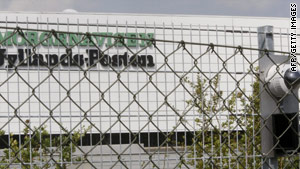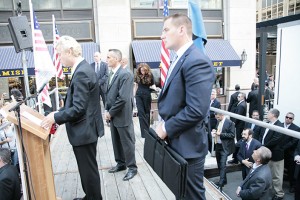The office of French satirical magazine Charlie Hebdo was badly damaged by a firebomb on Wednesday, after it published a spoof issue “guest edited” by the Prophet Muhammad to salute the victory of the Islamist party in Tunisia’s elections.
The magazine had announced a special issue for publication, renamed “Charia Hebdo,” a play on the French word for Islamic law. The magazine’s website has also been hacked with a message in English and Turkish. The fatwa said: “You keep abusing Islam’s almighty Prophet with disgusting and disgraceful cartoons using excuses of freedom of speech. Be Allah’s curse upon you!”
Charlie Hebdo is the latest in a series of “blasphemous pencils” – European cartoonists, writers and journalists threatened with death for their criticism about Islam. They are people who need a level of personal protection unconceivable even in Israel, a country well-known for its attention to security. And it happens all over Europe.Kurt Westergaard is the most famous of them. I spoke with him immediately after the attack in Paris. Westergaard is the Danish artist who created the controversial cartoon of the Prophet wearing a bomb in his turban: “Few days ago the police discovered another terrorist plan to attack my newspaper, the Jyllands Posten,” Westergaard said. “My house is protected as a bunker with cameras. I am always guarded by the policemen. Few months ago I had to attend a book presentation in Oslo. But the day before the Norwegian police asked me to cancel the event due to the terrorist threats.”
Five years after the publication of the cartoons, Westergaard still needs the same level of security of a Danish prime minister. “I am not a brave man, but I am 76-years-old and have less fear of dying”, the cartoonist said. “The terrorists won’t silence me in the battle for the freedom of expression.”
Visiting the Jyllands Posten’s office is like entering a US embassy in an Arab country. The newspaper had erected a 2.5-metre high, one-kilometer long barbed-wire fence, complete with electronic surveillance, around its headquarters in Visby. Mail is scanned and newspaper staff members need ID cards to enter the buildings and the various floors.
Flemming Rose is the cultural editor who took the initiative of publishing the cartoons. When he attended a conference in Oxford, the British police had to set up “the same protection as for Michael Jackson.” In Sweden the target is Lars Vilks, who was even named in a threat message sent prior to a suicide bombing in Stockholm last year. In the Netherlands, where filmmaker Theo van Gogh was killed by a fundamentalist for his criticism of Islam, cartoonist Gregorious Nekshot uses a pseudonym to protect his own identity.
‘Atmosphere of fear’
The office of Geert Wilders, the Dutch MP famous for his critics of Islam, lies in the most isolated corner of Parliament. It was chosen because potential terrorists can get through only one corridor, making it easier to protect him. Even the pencils of visitors are searched by the police. Wilders’ entourage is anonymous. He even slept for a while in a military barrack for security reasons. When the alert level is high, Wilders doesn’t know where he will spend the night.
“I could go to a restaurant, but the police should empty it before my arrival,” Wilders once told me.
At the University of Leiden, Rembrandt’s famous city, the office of Professor Afshin Ellian is protected by bulletproof walls and policemen. “In Holland Rousseau, Locke, Sade and Spinoza were able to publish their books,” Ellian said during our meeting in Leiden. “Holland was the hope of Europe. But it’s no more. Now there is an atmosphere of fear if you criticize Islam.”
I just recently spoke with Robert Redeker, the professor of philosophy condemned to death for an article in Le Figaro newspaper. His piece, a response to the controversy over remarks about Islam made a week earlier by Pope Benedict XVI, was titled “What should the free world do in the face of Islamist intimidation?” It was a fierce critique of what Redeker called Islam’s attempt “to place its leaden cloak over the world.” On an Islamist website, he was sentenced to death in a posting that, in order to facilitate a potential assassin’s task, also provided his address, telephone and a photograph of his home.
“I just went to Austria for a conference and even there the bodyguards were always with me,” Redeker said. The police did not even allow him to announce his father’s death, because someone could have noted the surname. “I had to bury my father like a criminal,” he said. The marriage of his daughter was also attended by the police.
Redeker had to sell his house and buy another one in a secret location. “I cannot go out to buy bread or newspapers or for a glass of wine. I cannot walk in the streets. I am a refugee in my own country. I cannot take the train, bus or subway. I cannot answer the question of what I can expect from the future. This new situation has changed my perception of time…It’s as there is no future for me.”
Europe is also becoming a no-go area also for Israelis. Last July, Israeli historian Benny Morris was walking towards the London School of Economics. He was accosted by a group of keffiyah-clad Muslims who, recognizing him, started hurling abuse, shouting and screaming in his face that he was a “fascist”, “murderer”, “racist” and that the UK shouldn’t have let him speak.
The police were called, but when they arrived, the Muslims disappeared. When Morris finished his lesson on Israel’s war of 1948, he was unceremoniously bundled away through the back exit of the faculty, past the garbage cans, out of fear for his safety if he left the building in the normal manner. “I felt like a Jew in Berlin in the 1920s,” Morris told me.
Kurt Westergaard’s last cartoon captured the atmosphere in Europe well. It depicts Westergaard as Don Quixote, leaving a donkey carrying a bomb with the word “ytringsfrihed” (freedom of speech.) Under the cartoon it says: “The Don Quixote of idealism says goodbye and thank you. The Sancho Panza of reality remains – for now.”












